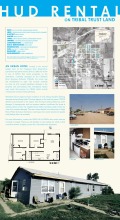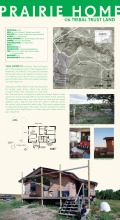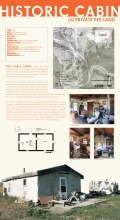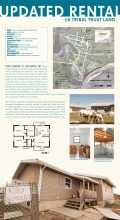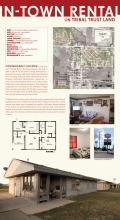These six posters represent common housing and construction typologies on the reservation. The information on the posters was collected through interviews conducted primarily in the summer of 2010. Our research focused on the Cheyenne River Reservation, but we also saw a number of innovative building projects on the Pine Ridge Reservation. Roughly 90% of the homes on Cheyenne River were constructed by the Housing Authority (CRHA) with HUD[1] grant money. Housing for all tribal members was one of the conditions of the 1868 Treaty of Fort Laramie, the last treaty made between the US and Indian Tribes.[2]
[1] HUD is the US Department of Housing and Urban Development. The tribe has a local housing department, the Cheyenne River Housing Authority (CRHA), which receives grants from HUD. Founded in 1963, the CRHA facilitated the construction of numerous rent-to-own homes, and now manages approximately 600 rental units on the reservation. Prior to 1980, the Housing Authority could only build homes that were designed by HUD, and were notoriously unsuited for the climate and poorly constructed. Since 1980, HUD grants have been given without design stipulations.
[2] This established the Great Sioux Nation, a 26 million acre area set aside for exclusive use by the Sioux. In 1874, gold was discovered in the sacred Black Hills, within Sioux territory. Following the US loss of the Battle of Little Big Horn (1876), the federal government confiscated the Black Hills. The Sioux never agreed to give up the Black Hills. In 1889, Congress divided what was left of the Great Sioux Nation into five smaller reservations, reducing Sioux land to 9 million acres. In 1980, the Supreme Court recognized the Black Hills were unfairly confiscated. The US government offered the Sioux a financial settlement, which to this day they have refused.

